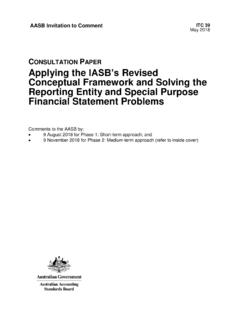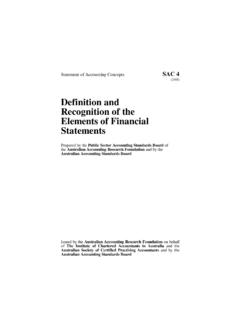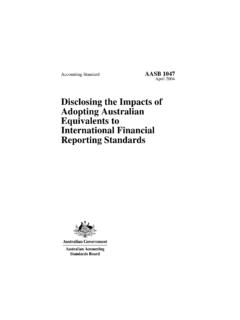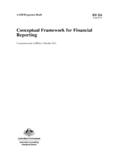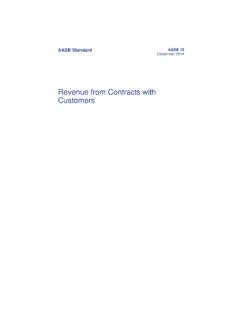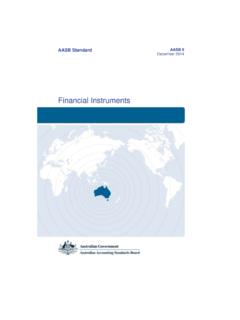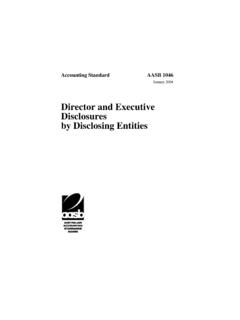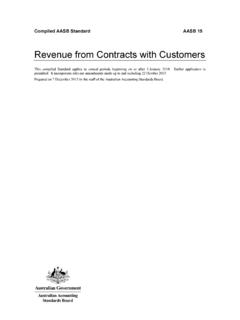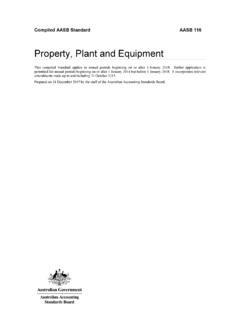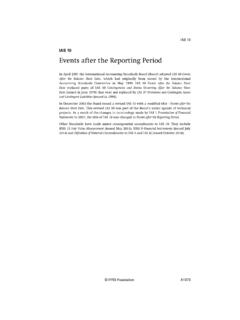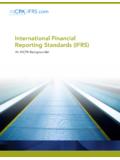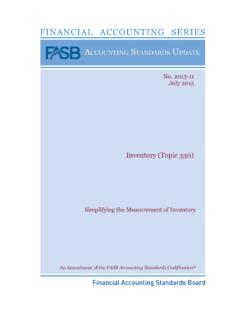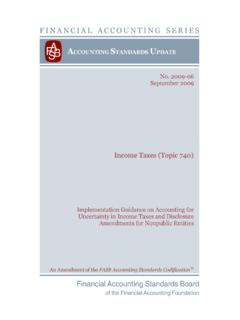Transcription of Statement of Cash Flows - Australian Accounting Standards ...
1 Compiled AASB Standard AASB 107 Statement of Cash Flows This compiled Standard applies to annual periods beginning on or after 1 January 2017 but before 1 January 2019. Earlier application is permitted for annual periods beginning on or after 1 January 2014 but before 1 January 2017. It incorporates relevant amendments made up to and including 23 March 2016. Prepared on 20 March 2017 by the staff of the Australian Accounting Standards board . Compilation no. 1 Compilation date: 31 December 2016 Authorised Version F2017C00279 registered 10/04/2017 AASB 107-compiled 2 COPYRIGHT Obtaining copies of Accounting Standards Compiled versions of Standards , original Standards and amending Standards (see Compilation Details) are available on the AASB website: Australian Accounting Standards board PO Box 204 Collins Street West Victoria 8007 AUSTRALIA Phone: (03) 9617 7600 E-mail: Website: Other enquiries Phone: (03) 9617 7600 E-mail: COPYRIGHT Commonwealth of Australia 2016 This compiled AASB Standard contains IFRS Foundation copyright material.
2 Reproduction within Australia in unaltered form (retaining this notice) is permitted for personal and non-commercial use subject to the inclusion of an acknowledgment of the source. Requests and enquiries concerning reproduction and rights for commercial purposes within Australia should be addressed to The National Director, Australian Accounting Standards board , PO Box 204, Collins Street West, Victoria 8007. All existing rights in this material are reserved outside Australia. Reproduction outside Australia in unaltered form (retaining this notice) is permitted for personal and non-commercial use only. Further information and requests for authorisation to reproduce for commercial purposes outside Australia should be addressed to the IFRS Foundation at Authorised Version F2017C00279 registered 10/04/2017 AASB 107-compiled 3 CONTENTS Contents COMPARISON WITH IAS 7 Accounting STANDARD AASB 107 Statement OF CASH Flows from paragraph OBJECTIVE SCOPE 1 BENEFITS OF CASH FLOW INFORMATION 4 DEFINITIONS 6 Cash and cash equivalents 7 PRESENTATION OF A Statement OF CASH Flows 10 Operating activities 13 Investing activities 16 Financing activities 17 REPORTING CASH Flows FROM OPERATING ACTIVITIES 18 REPORTING CASH Flows FROM INVESTING AND FINANCING ACTIVITIES 21 REPORTING CASH Flows ON A NET BASIS 22 FOREIGN CURRENCY CASH Flows 25 INTEREST AND DIVIDENDS 31 TAXES ON
3 INCOME 35 INVESTMENTS IN SUBSIDIARIES, ASSOCIATES AND JOINT VENTURES 37 CHANGES IN OWNERSHIP INTERESTS IN SUBSIDIARIES AND OTHER BUSINESSES 39 NON-CASH TRANSACTIONS 43 CHANGES IN LIABILITIES ARISING FROM FINANCING ACTIVITES 44A COMPONENTS OF CASH AND CASH EQUIVALENTS 45 OTHER DISCLOSURES 48 EFFECTIVE DATE 53 COMMENCEMENT OF THE LEGISLATIVE INSTRUMENT WITHDRAWAL OF AASB PRONOUNCEMENTS APPENDIX A Australian reduced disclosure requirements ILLUSTRATIVE EXAMPLES A Statement of cash Flows for an entity other than a financial institution B Statement of cash Flows for a financial institution C Reconciliation of liabilities arising from financing activities COMPILATION DETAILS DELETED IAS 7 TEXT AVAILABLE ON THE AASB WEBSITE Basis for Conclusions on IAS 7 Australian Accounting Standard AASB 107 Statement
4 Of Cash Flows (as amended) is set out in paragraphs 1 60 and Appendix A. All the paragraphs have equal authority. Paragraphs in bold type state the main principles. AASB 107 is to be read in the context of other Australian Accounting Standards , including AASB 1048 Interpretation of Standards , which identifies the Australian Accounting Interpretations, and AASB 1057 Application of Australian Accounting Standards . In the absence of explicit guidance, AASB 108 Accounting Policies, Changes in Accounting Estimates and Errors provides a basis for selecting and applying Accounting policies. Authorised Version F2017C00279 registered 10/04/2017 AASB 107-compiled 4 COMPARISON Comparison with IAS 7 AASB 107 Statement of Cash Flows as amended incorporates IAS 7 Statement of Cash Flows as issued and amended by the International Accounting Standards board (IASB).
5 Australian -specific paragraphs (which are not included in IAS 7) are identified with the prefix Aus . Paragraphs that apply only to not-for-profit entities begin by identifying their limited applicability. Tier 1 For-profit entities complying with AASB 107 also comply with IAS 7. Not-for-profit entities compliance with IAS 7 will depend on whether any Aus paragraphs that specifically apply to not-for-profit entities provide additional guidance or contain applicable requirements that are inconsistent with IAS 7. Tier 2 Entities preparing general purpose financial statements under Australian Accounting Standards Reduced Disclosure Requirements (Tier 2) will not be in compliance with IFRSs. AASB 1053 Application of Tiers of Australian Accounting Standards explains the two tiers of reporting requirements.
6 Authorised Version F2017C00279 registered 10/04/2017 AASB 107-compiled 5 STANDARD Accounting Standard AASB 107 The Australian Accounting Standards board made Accounting Standard AASB 107 Statement of Cash Flows under section 334 of the Corporations Act 2001 on 7 August 2015. This compiled version of AASB 107 applies to annual periods beginning on or after 1 January 2017 but before 1 January 2019. It incorporates relevant amendments contained in other AASB Standards made by the AASB up to and including 23 March 2016 (see Compilation Details). Accounting Standard AASB 107 Statement of Cash Flows Objective Information about the cash Flows of an entity is useful in providing users of financial statements with a basis to assess the ability of the entity to generate cash and cash equivalents and the needs of the entity to utilise those cash Flows .
7 The economic decisions that are taken by users require an evaluation of the ability of an entity to generate cash and cash equivalents and the timing and certainty of their generation. The objective of this Standard is to require the provision of information about the historical changes in cash and cash equivalents of an entity by means of a Statement of cash Flows which classifies cash Flows during the period from operating, investing and financing activities. Scope 1 An entity shall prepare a Statement of cash Flows in accordance with the requirements of this Standard and shall present it as an integral part of its financial statements for each period for which financial statements are presented. 2 [Deleted by the AASB] 3 Users of an entity s financial statements are interested in how the entity generates and uses cash and cash equivalents.
8 This is the case regardless of the nature of the entity s activities and irrespective of whether cash can be viewed as the product of the entity, as may be the case with a financial institution. Entities need cash for essentially the same reasons however different their principal revenue-producing activities might be. They need cash to conduct their operations, to pay their obligations, and to provide returns to their investors. Benefits of cash flow information 4 A Statement of cash Flows , when used in conjunction with the rest of the financial statements, provides information that enables users to evaluate the changes in net assets of an entity, its financial structure (including its liquidity and solvency) and its ability to affect the amounts and timing of cash Flows in order to adapt to changing circumstances and opportunities.
9 Cash flow information is useful in assessing the ability of the entity to generate cash and cash equivalents and enables users to develop models to assess and compare the present value of the future cash Flows of different entities. It also enhances the comparability of the reporting of operating performance by different entities because it eliminates the effects of using different Accounting treatments for the same transactions and events. 5 Historical cash flow information is often used as an indicator of the amount, timing and certainty of future cash Flows . It is also useful in checking the accuracy of past assessments of future cash Flows and in examining the relationship between profitability and net cash flow and the impact of changing prices.
10 Definitions 6 The following terms are used in this Standard with the meanings specified: Cash comprises cash on hand and demand deposits. Authorised Version F2017C00279 registered 10/04/2017 AASB 107-compiled 6 STANDARD Cash equivalents are short-term, highly liquid investments that are readily convertible to known amounts of cash and which are subject to an insignificant risk of changes in value. Cash Flows are inflows and outflows of cash and cash equivalents. Operating activities are the principal revenue-producing activities of the entity and other activities that are not investing or financing activities. Investing activities are the acquisition and disposal of long-term assets and other investments not included in cash equivalents.
